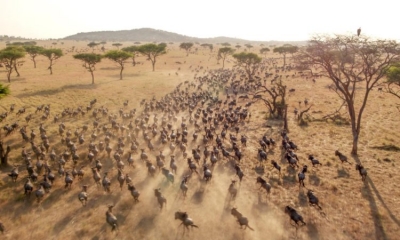
Contiguous with the Serengeti National Park along the Kenya-Tanzania border, the Maasai Mara National Reserve in south-western Kenya is one of the best-known and most-visited in the African continent Sprawling across more than 1,500 sq. km, and lying in the Rift Valley, the regions’s vegetation is varied from rolling grasslands and riverine forests to woodlands, swamps, and scrub. Teeming with wildlife, the Reserve is most noted for the Big Five – lion, cheetah, wild buffalo, rhinoceros, and wild elephant and for hosting the world’s most spectacular show in the wild- the annual wildebeest migration. In a circuitous journey, more than a million wildebeest, along with thousands of zebras and gazelles cross the crocodile-filled Mara river and brave several other predators such as lions during the journey between Serengeti and this Reserve.
Wildlife
The birds of the Reserve are ostriches, grebes, pelicans, cormorants, darters, herons, egrets, bitterns, storks, ibises, spoonbills, ducks, geese, secretary birds. vultures, eagles, kites, harriers, hawks, falcons, kestrels, quails, buttonquails, francolins, guineafowls, rails, crakes, moorhens, cranes, bustards, jacanas, stilts, thickknees, coursers, plovers, lapwings, painted snipes, sandpipers, terns, pigeons, doves, parrots, cuckoos, coucals, owls, nightjars, swifts, mousebirds, trogons, kingfishers, bee-eaters, rollers, hoopoes, hornbills, barbets, tinkerbirds. honeyguides, woodpeckers, wrynecks, larks, swallows, and martins. Impalas, wildebeest, antelopes, gazelles, rhinoceroses, zebras, elephants, buffaloes, pangolins, mongooses, hyenas, leopards, lions, cheetahs, foxes, jackals, wild dogs, honey badgers, monkeys, baboons, fruit bats, hares, squirrels, porcupines, hippopotamuses, warthogs, and giraffes are the mammals one can spot here, in addition to a whole lot of reptiles and amphibians such as tortoises, terrapins, snakes, lizards, toads, and frogs.
Threats
Among the Reserve’s threats and concerns are poaching for ivory and meat, encroachment, land used for agriculture, human-wildlife conflict, and forest fires. More importantly, tourism impacts the region in several ways. Tourism is an important part of the Reserve for the revenue it brings directly and indirectly. Tourists from developed nations visit the place and are keen to view wildlife as closely as possible. So tourist van operators drive very close to this animals causing them great distress. And continuous driving on these lands could affect the natural vegetation of the region the animals may be dependent on. However, that’s not the only way in which tourism affects the region.
Before 2004, not even 10 tourist lodges existed in and around the Reserve, because there was a ban on new construction. However, that was removed in 2004, and gradually over the last 1.5 decades, around 200 such lodges have come up. As it is fencing and agriculture had affected the movement of animals, even interfering with the migration route of a few animals. With increasing numbers of lodges, and therefore humans, the movement of wild animals could be severely hindered.
The pandemic effect
Before last March, tourism was of great concern due to the sheer number of visitors to the Reserve and how it affected the place and its inhabitants. But the pandemic brought with it a peculiar problem- the lack of tourists. As mentioned earlier, tourists bring revenue to the region directly through safari visits and indirectly by buying products – such as handmade jewellery – from the villagers around the region. Without tourists, these people’s livelihoods have been greatly affected. The larger fear is that without the earlier financial stability, gradually they “may stop protecting wildlife, resort to poaching to get by, or sell land”.
Picture Credit : Google



